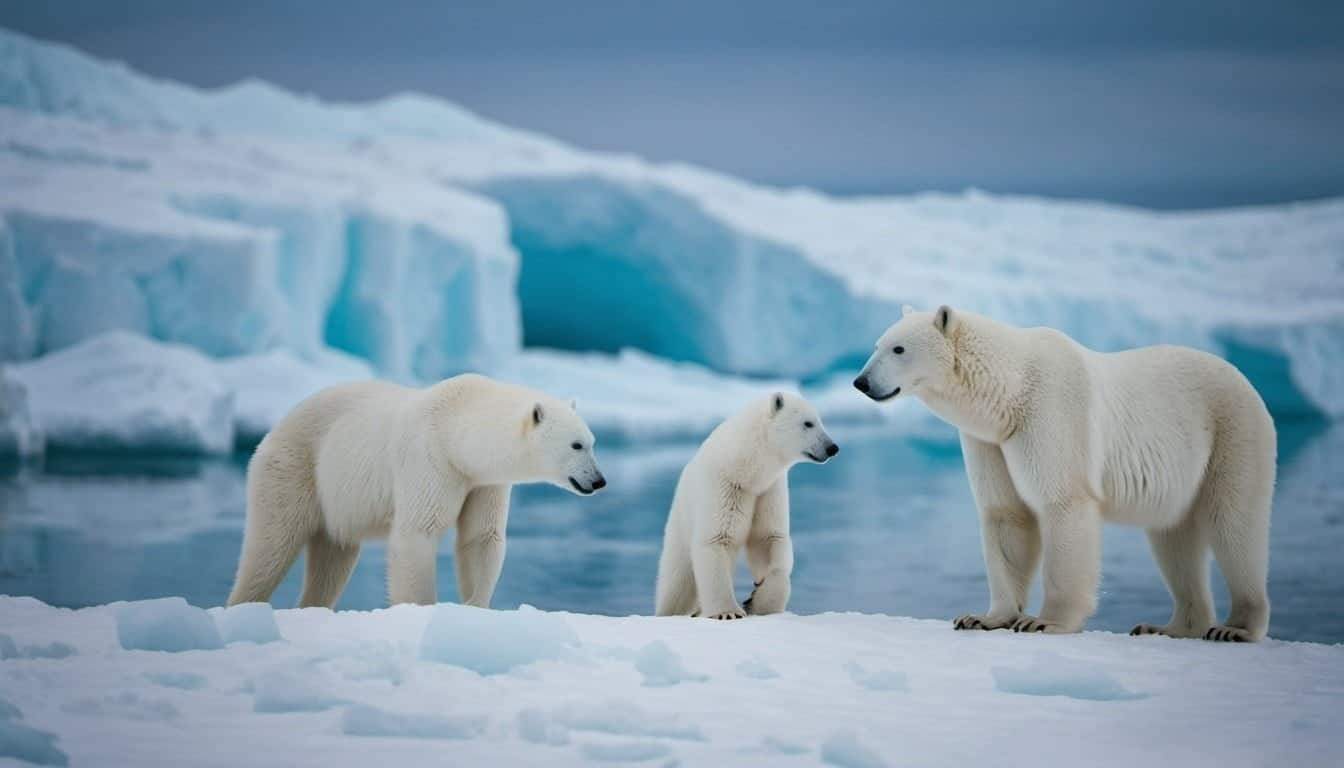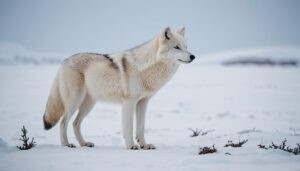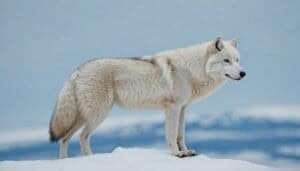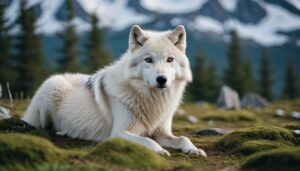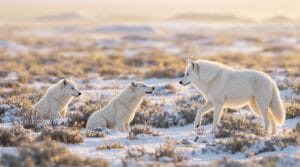Introduction
The presence of polar bears in the Arctic significantly impacts the lives of Arctic wolves. This article explores the intricate dynamics between these two species, focusing on their interactions, adaptations, and the effects of climate change
We will delve into their food sources, hunting behaviors, population dynamics, and the methods researchers use to study these fascinating relationships
Interaction Between Polar Bears and Arctic Wolves
The interactions between polar bears and Arctic wolves are complex, shaped by their shared environment and overlapping food sources. Understanding these interactions provides insight into the broader ecosystem dynamics of the Arctic
Food Sources and Competition
Polar bears and Arctic wolves primarily feed on different prey, but their food sources can overlap, leading to competition. Polar bears mainly hunt seals, which they catch by waiting at breathing holes in the ice or breaking into seal dens
In contrast, Arctic wolves primarily hunt caribou and musk oxen, often traveling great distances to find herds
However, when food is scarce, both species may scavenge carcasses or hunt smaller mammals and birds. In such cases, competition for resources can intensify, particularly in areas where both species’ ranges overlap significantly. Polar bears, being larger and more dominant, often displace wolves from carcasses, thereby impacting the wolves’ food availability and hunting success
Impact on Hunting Behavior
The presence of polar bears can influence the hunting behavior of Arctic wolves. Wolves may avoid areas frequented by polar bears to reduce the risk of encounters, which can alter their traditional hunting grounds and strategies
For example, if wolves are pushed into less optimal hunting areas, their success rate in capturing prey may decrease, affecting their overall health and survival
Additionally, wolves might adjust their hunting tactics to compensate for the presence of polar bears. This could include changing their hunting times to avoid peak bear activity or developing strategies to hunt more elusive prey. Such behavioral adaptations highlight the wolves’ resilience but also underline the additional stressors they face in an environment already challenging due to extreme conditions
Recorded Attacks and Aggression
While direct confrontations between polar bears and Arctic wolves are relatively rare, there have been recorded instances of aggression
Polar bears, being opportunistic predators, have been known to attack and kill wolves, particularly when food is scarce. These attacks are not typically for predation but rather to eliminate competition or in defense of a valuable food source
Conversely, there are few documented cases of Arctic wolves attacking polar bears, mainly due to the size and strength disparity. However, wolves in packs may attempt to harass or intimidate a bear to drive it away from a kill or a den site. Such interactions are dangerous and can result in injuries or fatalities for the wolves involved
Adaptations and Population Dynamics
The presence of polar bears in the Arctic environment influences the adaptations and population dynamics of Arctic wolves. These effects are evident in the behavioral and ecological strategies that wolves develop to coexist with their larger neighbors
Adaptations in High Polar Bear Areas
In regions with high polar bear populations, Arctic wolves exhibit several adaptations to mitigate competition and threats
One notable adaptation is spatial avoidance, where wolves alter their territories and hunting routes to minimize encounters with polar bears. This spatial segregation reduces direct competition for food and decreases the likelihood of aggressive interactions
Another adaptation involves changes in denning behavior. Wolves may select den sites in areas less frequented by polar bears, such as higher elevations or more inland locations. This choice not only protects their pups from potential bear predation but also ensures a safer environment for raising their young
Additionally, Arctic wolves may adjust their hunting schedules to avoid peak polar bear activity periods. For instance, they might hunt during times when polar bears are less active, such as midday when bears might be resting
This temporal adjustment allows wolves to exploit food resources with reduced risk of bear encounters
Population Impact and Dynamics
The influence of polar bears on Arctic wolf populations can be significant. In areas with high polar bear densities, wolf populations may experience increased mortality rates due to predation and competition for food. This pressure can lead to smaller, more fragmented wolf populations, affecting their genetic diversity and long-term viability
Conversely, in areas where polar bear populations decline, wolves might experience a temporary increase in food availability, particularly from scavenging bear kills
However, this short-term benefit can be offset by broader ecosystem changes that affect prey availability due to declining sea ice and changing climate patterns.
Polar bears also indirectly impact wolf populations by influencing the populations of shared prey species. For example, if polar bears overhunt certain prey like seals or other marine mammals, it can lead to a decrease in those populations, indirectly reducing food availability for wolves who might scavenge those remains
Influence of Climate Change
Climate change exacerbates the interactions between polar bears and Arctic wolves by altering their shared habitat. Melting sea ice reduces the hunting grounds for polar bears, pushing them closer to wolf territories on land
This increased overlap can intensify competition and lead to more frequent and aggressive encounters between the two species
Additionally, climate change impacts the distribution and abundance of prey species. For example, warming temperatures and changing vegetation patterns can shift the ranges of caribou and musk oxen, key prey for wolves. As these prey species move, wolves must adapt their hunting strategies and territories, often bringing them into closer contact with polar bears
Overall, the interplay between polar bears and Arctic wolves under changing climate conditions underscores the complex and dynamic nature of Arctic ecosystems. Understanding these relationships is crucial for conservation efforts aimed at preserving both species in a rapidly changing environment
Research and Observations
Studying the interactions between polar bears and Arctic wolves requires specialized research methods and provides valuable insights into the dynamics of Arctic ecosystems. This section explores how researchers investigate these interactions and what their findings reveal
Methods of Studying Interactions
Researchers employ various methods to study the interactions between polar bears and Arctic wolves
One common technique is direct observation, which involves tracking and monitoring the movements and behaviors of both species in their natural habitats. This method can provide real-time data on encounters, hunting behaviors, and spatial dynamics
Another crucial method is the use of GPS collars. By fitting polar bears and Arctic wolves with GPS collars, researchers can collect precise data on their movements, territory ranges, and interactions over extended periods. This technology helps scientists understand how these animals use their habitats and how often their paths cross
Additionally, researchers analyze scat and carcasses to gather information about diet and competition. By examining the remains of prey animals, scientists can determine the extent to which polar bears and Arctic wolves compete for the same food resources. This analysis can also reveal changes in diet composition that may result from climate change or other environmental factors
Finally, remote cameras are widely used to capture images and videos of wildlife. These cameras are strategically placed in areas frequented by both species, allowing researchers to document their interactions without human interference. This non-invasive method provides valuable visual evidence of behavior and encounters
Findings and Implications
Research findings highlight the complex relationship between polar bears and Arctic wolves. Studies have shown that while direct conflicts are relatively rare, competition for food resources can significantly impact wolf populations
For instance, in areas where polar bears dominate carcasses, wolves may experience reduced food availability, affecting their health and reproductive success
Researchers have also observed behavioral adaptations in wolves living in close proximity to polar bears. These adaptations, such as altered hunting patterns and spatial avoidance, demonstrate the wolves’ ability to adjust to the presence of a dominant competitor. However, these adaptations can also lead to increased energy expenditure and stress, impacting the wolves’ overall fitness
Climate change has been identified as a critical factor influencing the interactions between polar bears and Arctic wolves. Melting sea ice forces polar bears to spend more time on land, increasing their overlap with wolf territories. This shift can intensify competition and alter the dynamics of prey populations, creating a ripple effect throughout the ecosystem
The implications of these findings are significant for conservation efforts. Understanding the interactions between polar bears and Arctic wolves helps scientists predict how both species will respond to ongoing environmental changes
This knowledge is essential for developing effective management strategies aimed at preserving the delicate balance of Arctic ecosystems
Efforts to mitigate the impacts of climate change, protect critical habitats, and ensure sustainable prey populations are vital for the long-term survival of both polar bears and Arctic wolves. Continued research and monitoring are necessary to adapt conservation strategies to the rapidly changing conditions in the Arctic
Conclusion
Understanding the complex relationship between polar bears and Arctic wolves is essential for grasping the broader dynamics of the Arctic ecosystem. The presence of polar bears influences Arctic wolves in several ways, from competition for food resources to behavioral adaptations and population dynamics
As climate change continues to alter the Arctic landscape, these interactions become even more critical to study
Research methods such as direct observation, GPS tracking, scat analysis, and remote cameras provide valuable insights into how these species coexist and compete. Findings reveal that while direct conflicts are rare, competition for food significantly impacts wolf populations and behavior
Wolves adapt their hunting strategies and territories to mitigate the presence of polar bears, demonstrating resilience but also facing increased stress and energy expenditure
Climate change exacerbates these interactions by reducing sea ice, forcing polar bears onto land and increasing overlap with wolf territories. This shift intensifies competition and affects prey populations, creating cascading effects throughout the ecosystem
Conservation efforts must consider these dynamics to develop effective strategies for preserving both species and the delicate Arctic environment
Continued research and adaptive management are crucial for mitigating the impacts of climate change and ensuring the survival of polar bears and Arctic wolves. Protecting their habitats, maintaining sustainable prey populations, and addressing the broader environmental changes are vital steps in conserving the Arctic’s unique and fragile ecosystem
